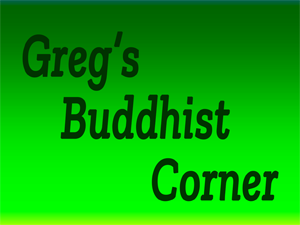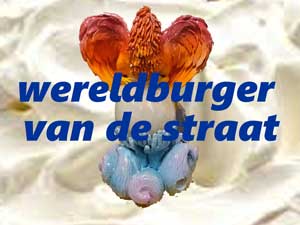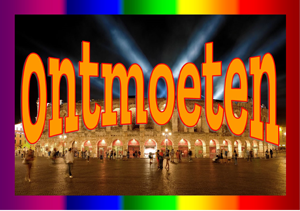Becoming Avalokiteshvara: The Buddha of Compassion
By Greg Suffanti
QFWF no. 6, Yangsi Rinpoche visits Maitreya Amsterdam, 2018/June-July
The different Buddhist deities are like the many organs in the one body
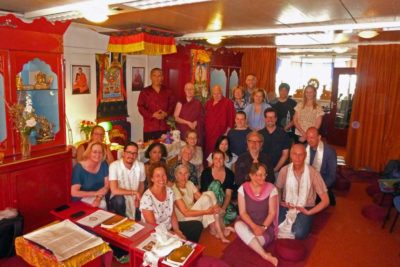
For the uninitiated, Tantric empowerments or initiations, must seem like rather exotic and somehow otherworldly affairs; or at least, that’s what I imagine what most non-Buddhists must think. In order to hopefully give a bit of insight into exactly what happens during such an event, I’ll share with the reader the notes I took during the teachings from Yangsi Rinpoche’s Tantric initiation at Maitreya Instituut in Amsterdam this past weekend.
The event started on the 29th of June, and concluded on the 1st of July 2018. Rinpoche’s long weekend was a “1,000 Arm Chenrezig jenang and retreat”.
A jenang is a Tantric ritual/initiation for a specific Buddhist deity or yidam in which the Buddhist practitioner receives a blessing or an empowerment to practice that specific yidam.
Unless you have a received a wang, or “great initiation”, you cannot visualize yourself as the deity. Instead, when you are doing the deity practice, you visualize the deity just above the crown of your head. Wang means permission to enter the mandala of the deity and to also generate yourself as the deity. You can either take the initiation as a blessing, or fully take it, meaning that you also accept whatever daily commitments the lama decides to connect with taking the jenang.
As a Buddhist, if you feel connected to a particular deity, you may want to take an initiation. You have to be careful though, as there are many stories of people giving back their vows and commitments due to their being unable to actually meet their daily commitments. That is most unfortunate.
When you look at all these different Buddhist deities, you should not think that they are all somehow separate from one another, for they are more like the various organs functioning in the one body. Just like sometimes you are mad, and sometimes you are happy… you are still the same, one person. The various Buddhas and yidams represent the various and different qualities of the same enlightening force.
Tantra is like a snake in a tube
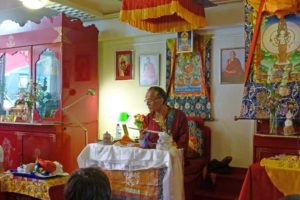
A Tantric initiation is a private affair, so I’ll not include descriptions of some of the rituals and instructions, and in this way I am respecting the Tibetan Buddhist tradition to which I belong. It is possible to easily obtain such information should you actually want it.
However, it should be noted that Buddhism is an oral tradition, and permission is required to take most Tantric empowerments. Further, because Buddhism is an oral tradition, it is said that the blessings that come to you during such an event, are unbroken and are from all the Buddhas and Bodhisattvas. This happens if you are a suitable vessel, and the teacher, a qualified master. Trying these things on your own can lead to confusion or even more problematical situations. Simply relying on reading Buddhist texts without the advice of a personal teacher is never recommended when following the Buddhist path, and certainly not when talking about practicing Tantra.
There are four classes of Tantra:
- 3 Outer Classes: Kriya Tantra, Charya Tantra, & Yoga Tantra
- 1 Inner Class: Anuttaryayoga Tantra
(Today’s initiation belonged to the Kriya Tantra class)
Let the buyer beware, for it is said that Tantra is like a snake in a tube: there are only two ways to go; up to the heavens, or directly to hell. Tantra is called the “quick path”, because as Lama Zopa Rinpoche says,
“there is opportunity to do meditations on the path that are similar to the four purities, the four complete results that we will achieve in the future when we become enlightened.”
He wasn’t there to judge us, he was there to help us
Yangsi Rinpoche visited our small center for three days, giving a 1000 Arm Chenrezig jenang and retreat to about thirty participants. It was possible to just attend the initiation, or to simply attend the teachings.
Rinpoche was not strict about these things. In fact, Yangsi Rinpoche was not strict about anything. This gentle giant of a man, with his large head and angular face, tall frame, broad shoulders and large feet and hands, seemed to just barely fit into our small gompa (prayer room). Once seated, Rinpoche’s voice never rose above a gentle whisper, and it felt as if everything he was telling us was intimate and private; like personal advice between friends. He was always relaxed and happy, and he encouraged us to also be relaxed and happy and natural in our lives and in our Buddhist practice. He emphasized that we wanted to broaden our outlook, in a positive, sustainable way.
Rinpoche talked a great deal about the emotional elements of faith and compassion, describing the emotions that are aroused as a form of powerful concentration that could be used to move us further along the Buddhist path.
He emphasized the need we have to challenge ourselves, and our egos, so that we can more fully connect with ourselves, and therefore have a healthy sense of self and a healthy, smooth functioning ego. He said,
“you need to touch a deeper way that you perceive yourself. It is necessary to bring this (your sense of self) into your heart; otherwise it becomes dry and analytical.”
Rinpoche said,
“we need to find our balance,” because “we want to be successful” and “we need to cherish ourselves, otherwise how can we cherish others?” He concluded, “we’re looking for a healthy sense of self.”
There were no barriers between teacher and student
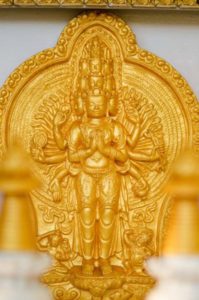
It quickly became apparent that this warm, striking man, who spoke sweetly and humorously, as well as profoundly, was the very embodiment of Avalokiteshvara (or Chenrezig), the Buddha of Infinite Compassion.
He wasn’t there to judge us, he was there to help us better connect with our own humanity. At the end of teachings on the second day, this gentle giant slowly navigated our small gompa before departing; offering his hands to each person present, while looking them in the eyes and sincerely thanking them for coming.
Rinpoche has been on a busy teaching tour, and he was tired after teaching all day; you could see it on his face. However, his smile was fresh and genuine with each person, and I could see on the faces of the attendees, that they were deeply touched by this very simple, warm and natural gesture from Rinpoche.
There were no barriers between the lama and his students, and this small gesture encapsulated the feel of the entire weekend: open, natural and intimate.
Yangsi Rinpoche teaches in English around the world, and is the President and Professor of Buddhist studies at the Maitripa college in Portland, Oregon, which he founded in 2005.
Rinpoche enjoys Western culture and easily uses expressions like “freak out” to clearly demonstrate his understanding of the Western mind. Rinpoche is a renowned scholar and practitioner from Western Tibet.
At the age of six he was enthroned as the incarnation of Geshe Ngawang Gendun, one of Lama Yeshe’s main teachers at Sera Monastery in Tibet.
We are here for the practice of loving kindness
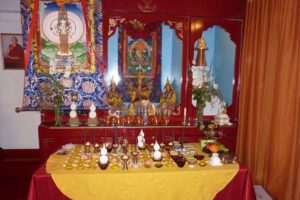
The gompa at Maitreya Instituut in Amsterdam was specially prepared for Yangsi Rinpoche’s Tantric weekend. In addition to the normal offerings of lights, water bowls and flowers, there was a special offering table, with more water bowls, tormas (offering cakes made of flour and butter) and tea lights.
The lama performing the ceremony also has preparations before the actual ceremony itself, including generating the self as the deity. Usually, a lama is alone in the gompa for this portion of the preparation for the ritual, but I can recall seeing His Holiness the Dalai Lama, in meditation posture, on stage and in full view whilst preparing for an initiation, at a sports arena in Hamburg, Germany in 2007.
Yangsi Rinpoche began Friday morning by encouraging us all to
“keep (our) intention to creating positive karma and positive group karma.”
Rinpoche remarked how beautiful it was to see all the bicyclists in Amsterdam, adding,
“I want to try that myself.”
Rinpoche said that
“due to causes and conditions we are here for the practice of loving kindness. That is our purpose and our objective. We should keep a very simple and a very clear motivation.”
We need karma coaching
“In Tibet, (initiations) it is a group effort. The whole community gets together to read sutras together, they do the Wind Horse practice, or prayer flag hanging, they offer incense and do the tea offering. This is a way of creating a great deal of positive group karma. They do lots of preparation and merit producing activities to make (the initiation) more powerful.”
“Merit is fundamental. Sometimes we have the skill, but things don’t work out due to lack of merit. (We need) cultivation of positive energy based on pure intention. We want to be spiritually grounded. The merit (you create) will strengthen your foundation. We need karma coaching.”
Merit producing is not intellectual, it’s spiritual
“Once the land is dry, nothing will grow. We need to create lush circumstances with the Dharma (the teachings of the Buddha). Merit producing is not intellectual, it’s spiritual. A pure and open mind is needed. (We need) less interference from all the noisy minds (we normally have); the noisy, tricky mind. We need a pure mind with pure intention, which creates positive potential. We as a society are going through a merit recession. Recession creates fear. (Therefore) merit accumulation needs to be a part of our daily life. Sometimes, we just need more merit.”
My devotion is my beauty
“We are trying to become real human beings, instead of being run by something (our runaway mind). We need to reach and find our fundamental humanness. Usually, we are so distracted and driven by fear. We need to understand what the word devotion means. There’s an element of emotion needed. No need to be scientific. We need a deeper understanding of devotion … of the divine.”
“Devotion and faith fully welcome logic and reason. We become extremes sometimes. We humans have thermostats; we don’t want to be too hot or too cold. We have to find a balance inside with (our) faith and devotion and wisdom. (We) need collaboration and cooperation (between these elements which) functions through our devotion.”
Like home, where you feel safe and comfortable
“We need to reduce our reactive mind. Don’t try to focus. Don’t feed your reactive mind. Try to stay in a space of calmness. All your Dharma practice can be condensed into your refuge practice. The source of your Dharma practice comes through your refuge practice. It is like home, where you feel safe and comfortable. Refuge practice is like your spiritual house. You feel safe and nurtured in your -refuge, so that you don’t become spiritually homeless. In (your) refuge you have space to grow and improve and expand your world. How do you expand your knowledge of refuge? Through the three jewels, of course! (Buddha, Dharma & Sangha). Refuge is your main house, not your beach house!” (laughter)
Avalokiteshvara is a blessing to awaken our own loving kindness
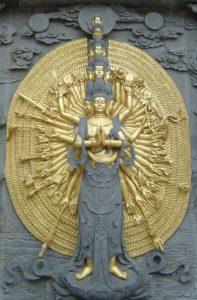
“Avalokiteshvara is a blessing to awaken your own loving kindness, which is the source of our happiness. (Should think) I’m receiving this (initiation) so that I can benefit more sentient beings. We want to line up our body, speech and mind into compassionate behavior. This is the way to develop yourself.”
Rinpoche then compared this lining up of body, speech and mind to a chiropractor lining up the spine.
“We’re looking for a unified spiritual energy which is united under devotion. (We’re looking for) a total absence of ego.”
We are trying to create a healthy ego
“You can have a healthy ego; a cultivated ego; not one that dictates, but one that gives you some sort of balance. We are trying to create a healthy ego. Slowly, slowly, we embrace loving kindness.”
“We need to understand our karmic reality as well as reality as a whole. Emptiness of self and phenomena. We need a practical element as well, understanding how the ego works. We need a holistic approach.”
Loving kindness is different than compassion
“Loving kindness is different than compassion. Here, we are talking about Bodhicitta (the altruistic wish to benefit others). Compassion is an emotional state. We feel the pain and suffering of others and wish we could do something. “I wish I could do something.” Very much about service.”
“Loving kindness is not necessarily focused on the pain, but, on the opposite; happiness and joyousness. “I wish he/she were happy and joyful.””
“We need both (compassion and loving kindness) and the answer to this is Bodhicitta. This is a long term solution. Bodhicitta, (meaning) first you help yourself, so that you can help others.”
Try not to see so many details
“We need to train in how we connect with others. Are we connecting with them as a human being?
We need to be open and not so specific. The way to train is having a wider, bigger perspective. All the detail becomes secondary, this is distracting.”
“Try not to see male/female, country, parents, etc. When we see our parents or His Holiness the Dalai Lama we see “same”. (There are) not so many details. With people we don’t know, we create superficial differences.”
“We need to train so that our compassion is less limited.”
“We need to find our balance, we want to be successful. You want wise self-cherishing. Sometimes self-cherishing is healthy, and sometimes not.”
“You need to cherish yourself, otherwise how can you cherish others? You don’t want self-neglect, that is wrong.”
We need a different foundation
“Our ego should be shy when we see Chenrezig (or Avalokiteshvara). All of the problems in the world come from egotistical grasping. If ego grasping doesn’t work, what does? Replace with a Bodhicitta motivation. We need a different foundation. We can help our feelings about our circumstances by having a Bodhicitta motivation.”
Rinpoche emphasized that we need to believe in our own ability to positively impact our lives and the lives of those around us.
Rinpoche also discussed the importance of the Seven Limb prayer, in terms of dealing with and cultivating a healthy ego, as well as the Eight Verses of Mind Training, which Rinpoche called “shock therapy for the ego.” He even advised that
“you could use the Eight Verses after a particularly bad day,” adding, “this is surgery for the ego. The Eight Verses are like lojong bootcamp.” (lojong practices are aimed at helping one lessen one’s own (mental) suffering)
Also during the three days, each of the participants took turns reading aloud from Dharmaraksita’s “Wheel of Sharp Weapons”, as a way of understanding the actual causes of our many and varied sufferings.
How to Meditate
On the third and final day, Rinpoche gave some practical advice about meditation. He suggested that:
“you don’t want to make your meditations long. You should do a Shamatha meditation each day. (Shamatha are Buddhist meditations to calm the mind). You should not hurry.”
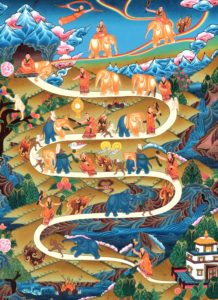
(During this process)
“You take out your mental garbage, or at least, (you are) not creating more mental garbage.”
We need to bring moisture to this dry mind
“How to work with the wandering, craving, hungry, thirsty mind? We need to bring moisture to this dry mind …. The mind that constantly wants something. Here, at the beginning, we are looking to calm that specific mind.”
“Work within simplicity and satisfaction. You are not running from something. (There is) Nothing to focus on. Ease, acceptance and a settled mind is what we’re looking for. Then, you get clarity of mind.”
We are open and feel no barriers
“Then, (your) mind is opened to devotion or faith. The mind and the emotions are not trying to constantly put up a wall. (There is) No emotional barrier.”
“Doubt, fear and suspicion … these minds we work away from.”
“Now, you are a bit purified; your mind leans toward that feeling of devotion and peace. Later on, when you choose an object of meditation, choose something that inspires your heart, and doesn’t trigger any of your (mental) afflictions.”
We are looking for balance
“We want a natural sort of concentration. (This is) The reason to have a strong object of meditation. We don’t want to be forcing ourselves during the day. We are looking for balance.
“Meditation on emptiness (the lack of inherent existence of both self and phenomena) is taking a multivitamin. This is a personal journey and a natural process (of cultivating) your spiritual values. Dharma is medicine.”
How do we keep our emotions and awareness healthy?
normally we have a dualistic mind.”
We are constantly grabbing after phenomena and ourselves as though everything is fixed and permanent. Rinpoche then advised a meditation of emptiness, or even, “a dose of nihilism, just to get off of habits of grabbing at (non-inherently existing) things (like) we normally (do).”
You are looking for the eye of the hurricane
Regarding calming the mind, Rinpoche advised,
“scanning of the grasping mind (until) recognizing this particular mind.” Then, “scanning deeper and (seeing) how you’re being very tense.” This is about “self-research and reflection. You’re looking for the eye of the hurricane, and not getting distracted by the noisy mind.”
“80% is really finding the center of all that energy that is validating the ego. You are deconstructing (the ego), and the other 20% (is seeing) the inner ego constructions of the self.”
“A healthy sense of self is how the wise go (forward to) develop … (their) perspective (of themselves) … (this perspective) comes from wisdom. You keep the (Buddhist) middle way (approach to life).”
There is an expression of freedom and liberation
“You need to touch a deeper way that you perceive yourself. It is necessary to bring this into our heart … otherwise, it becomes dry and analytical.”
“Scan your grasping mind. Conscious level is wild. (At) Sub-conscious (level there is) more shine. (To experience this) Meditation is required. Then you look for your intrinsic self.”(Doing a meditation on emptiness)
Rinpoche then talks about
“songs of experience,” because, he says, “you need to express your wisdom”, or maybe sing about your “compassion or Bodhicitta practice”.
This is a living, breathing process, and Rinpoche emphasizes that spirituality is an expression of freedom and liberation, as are methods such as songs of experience,
“as a way of motivating yourself.”
We are looking for our own humanity
Finally, Rinpoche concluded by saying,
“we are looking for our own humanity. We need to bring in the personal.”
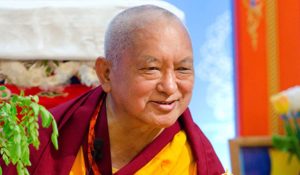
At the conclusion of the weekend, there was a Mandala offered to Rinpoche during a short ceremony, after which the dedication prayers were read. These included dedications for the spiritual director of the FPMT, Lama Zopa Rinpoche, and His Holiness the Dalai Lama. There was a special dedication prayer for the long life of Yangsi Rinpoche, which we read aloud. The prayer was composed in 1974 by Lama Thubten Yeshe.
Finally, those who wished, offered envelopes with donations and khatas (white Buddhist offering scarves) to Rinpoche.
Then, this very soft and quiet Buddhist Lama left the gompa, and our small center, leaving on foot, just as he had each day, waving goodbye before disappearing from view, on a gloriously perfect summer Sunday afternoon in Amsterdam.
… and that, dear reader, (without the rituals and explanations) is what it was like to attend a Tantric weekend from a great master. As you can see, just like everything else in the Buddhist canon, the rituals, symbols and deities are representations of the enlightened qualities of the body, speech and mind of all the Buddhas and Bodhisattvas.
The whole point, is to discover and grow these very same qualities within ourselves. Being around someone like Yangsi Rinpoche for a few days makes anything seem possible.
Notes
[1] Source: purifying-your-forefathers-killing-karma
[2] Source: Avalokiteshvara, Mount Jiuhua, Anhui province, China — photo Nat Krause
[3] Source: samatha-thangka-painting
[4] Source: lama-zopa-rinpoche

